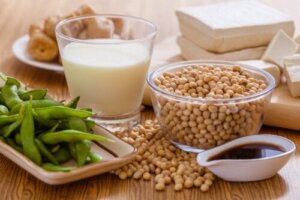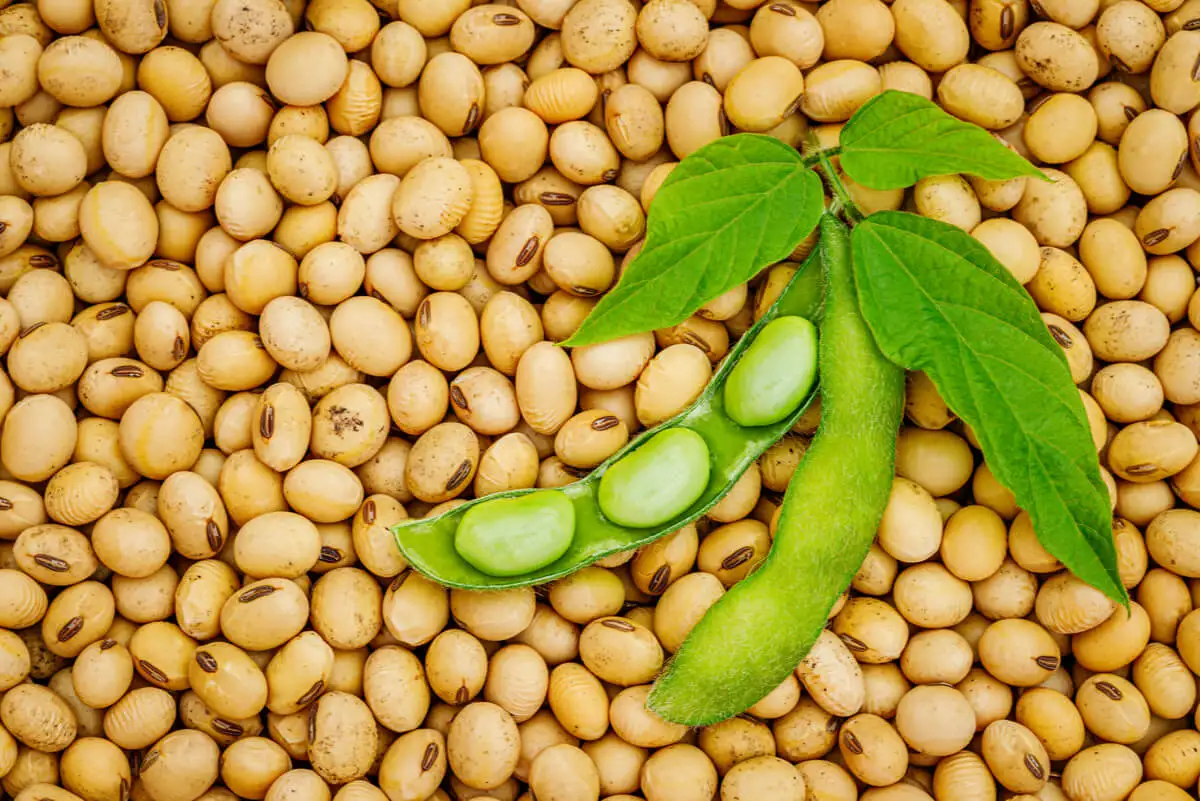Does Eating Soy Increase Your Risk of Breast Cancer?


Written and verified by the doctor Maryel Alvarado Nieto
Breast cancer is the most frequent neoplasm in women worldwide. However, the incidence differs between Asian countries and those of the West, which has led to thinking that diet could be involved. For this reason, several studies have been carried out on some foods and, in particular, on the relationship between soy and breast cancer.
The results of studies are so varied that they even contradict each other.
The greatest controversy arises in the types of tumors that are estrogen-dependent. In this type of neoplasm, the cancerous tissue possesses receptors that allow the cells to proliferate in the presence of this hormone. Therefore, they’re considered estrogen-sensitive tumors. Let’s take a closer look.
Soy: A food with hormonal similarity
Soy is a legume with high nutritional content. In addition, its components include isoflavones, pigments whose chemical structure resembles estrogen.
It’s because of the presence of these compounds, which are also called isoflavones, that concern has arisen about estrogenic tumors.
Estrogen is a female sex hormone, estrogen is a female sex hormone. It’s produced by the ovaries and, to a lesser extent, by the adrenal glands. It’s involved in a variety of bodily functions, including the proliferation and differentiation of breast tissue. Estrogen levels vary with a woman’s age and decrease with menopause.
We think you may be interested in reading this, too: 6 Bad Habits to Avoid if You Don’t Want Sagging Breasts
Isoflavone and its estrogenic action
Although isoflavones share structural similarities with estrogens, little has been discovered as to their action. In fact, of all the phytoestrogens, genistein has the highest biological activity and is the most studied. However, its effect differs in different tissues and also seems to vary with respect to endogenous estrogen levels.
Several studies have shown that the isoflavones present in soy can have an estrogen-like action and are therefore considered to be agonists. Or, on the contrary, they may block the effect of the hormone and this action is called antagonism.
This duality depends on the type of estrogen receptor to which they bind. For this reason, their effect is considered to have weak estrogenic and anti-estrogenic activity.

Is soy a protective or risk factor for breast cancer?
Studies have been conducted that propose isoflavones as a source of protection against the development of breast cancer. However, these investigations warn that frequent consumption of soy and its derivatives must occur in childhood and adolescence to produce a significant effect on the possible prevention of neoplasia.
Similarly, the authors state that a low consumption in puberty, followed by a diet rich in soy in adulthood, does not demonstrate the same protective action, and may even be insignificant. For this reason, they insist on incorporating the legume into a balanced diet from the early stages of life.
The explanation for this phenomenon is attributed to the fact that, in adolescence, phytoestrogens stimulate the proliferation and differentiation of breast tissue. Therefore, they provide protection against the development of neoplasia in future stages. However, there are those who consider that the protection of soy against breast cancer occurs through actions that don’t even depend on hormones.
Estrogens versus phytoestrogens
On the other hand, the levels of endogenous estrogen – that is, the types of estrogen produced by the body itself – also seem to influence the action of isoflavones. When hormone levels are low, as occurs after menopause, the estrogenic action of soy is greater. This is the reason why some consider it harmful to consume the legume after the menstrual cycles have ceased.
Like this article? You may also like to read: Itchy or Painful Breasts: Treatment and Possible Causes
Soy and breast cancer: The origin of the controversy
The fear of consuming soy and developing breast cancer after menopause or in those people at high risk of suffering from neoplasm arose from experimental studies carried out in rodents. These animals had their ovaries (the main source of estrogen) and thymus removed and were inoculated with cancer cells from an estrogen-dependent human breast tumor.
To mimic the dose of the hormone in postmenopausal women, mice were injected with small amounts of estradiol. A subgroup was then given daily doses of dietary genistein. In the studies, they observed that the mammary tumor grew in those animals receiving genistein. This led to the assumption that soy was contraindicated in women with breast cancer.
Limitations of the study
However, the experiment cannot be extrapolated to humans. This limitation responds to the physiological differences that exist in the metabolism of isoflavones between both species, which were not considered from the beginning.
In addition, dietary genistein was administered and not soy as a source of isoflavones, leaving aside the interaction of the other components of the legume. Moreover, such effects have not been observed in other rodent studies, making further research necessary to draw scientifically valid conclusions.

Possible conclusions regarding soy and breast cancer
Further studies are required to elucidate whether soy has any real benefit in the prevention of breast cancer or if, on the contrary, it represents a risk in the development of tumors. In the meantime, moderate consumption is considered to cause no negative health effects.
However, studies are inconclusive as to what is the best course of action to follow in cases of postmenopausal patients diagnosed with estrogen-dependent breast cancer, those who are at high risk of developing it, and survivors of cancer with anti-estrogen treatment.
The current levels of evidence are so disparate that it’s difficult to see the big picture. However, soy consumption has not been associated with an increased risk of breast cancer; at least not so far.
Therefore, suspicion against the consumption of this legume isn’t justified. However, it’s true that individual beliefs should be respected.
Apart from giving soy the leading role in the difference in breast cancer cases between Asia and the West, other possible risk factors involved in the development of the neoplasm should be evaluated, since there are many of them. Research aims to discover and propose substantial changes in people’s lifestyles in order to prevent breast cancer.
All cited sources were thoroughly reviewed by our team to ensure their quality, reliability, currency, and validity. The bibliography of this article was considered reliable and of academic or scientific accuracy.
- Morales, C.; Hammu, K.; Moral, J.; Relación entre el Consumo de Soja y el Desarrollo de Cáncer de Mama: Revisión no Sistemática; Archivos de Medicina Universitaria; 2 (1); 2020.
- Biloni, M.; La Incidencia de la Ingesta de Isoflavonas en el Desarrollo de Cáncer de Mama en Mujeres Posmenoupáusicas; Instituto Universitario ISALUD; 2010.
- Mayo Pérez, B., Flórez García, A. B., & Vázquez, L. (2018). Isoflavonas y equol: mito o realidad.
- Aparicio, M.; Jiménez, M.; Isoflavonas: menopausia y Cáncer de Mama; Universidad Complutense – Facultad de Farmacia; Trabajo de Fin de Grado; 2018.
- Shu XO, Zheng Y, Cai H, et al. Soy Food Intake and Breast Cancer Survival. JAMA. 2009;302(22):2437–2443. doi:10.1001/jama.2009.1783
- Rosón, F.; Antinutrientes de la Soja; Universidad de Valladolid; Trabajo de Fin de Grado; 2017.
- Pérez, O.; Domínguez, L.; Zumbado, M.; Fitoestrógenos y Cáncer; Biocáncer; 2004.
- Hernando, O.; Rubio, M.; Nutrición y Cáncer; Nutrición Hospitalaria; 32 (Supl. 1); 2015.
- Garrido, A., de la Maza, M. P., & Valladares, L. (2003). Fitoestrógenos dietarios y sus potenciales beneficios en la salud del adulto humano. Revista médica de Chile, 131(11), 1321-1328.
- Pérez, A.; Mach, N.; Efecto del Consumo de Soja en Relación con los Síntomas de la Menopausia; Revista Española de Nutrición Humana y Dietética; 16 (2): 69 – 76; 2012.
This text is provided for informational purposes only and does not replace consultation with a professional. If in doubt, consult your specialist.








